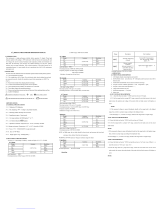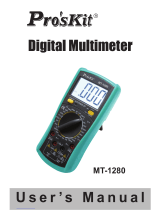Page is loading ...

- 1 -
DT58 Series
DT5801/DT5802/DT5803/DT5804
DT5805/DT5806/DT5807/DT5808
Large LCD display
DIGITAL MULTIMETER
OPERATOR’S
MANUAL

- 2 -
1. INTRODUCTION
This DT58 Series Digital Multimeter is a compact precision, battery operated,
LCD display 3-½ digits Digital Instrument..
Superiority:
9 High accuracy
9 Digital height 22mm
9 Single 30 position rotary switch for FUNCTION and RANGE
selection, allows fast and convenient operation.
9 Curvilinear mode soft case.
9 Colored indication jack with fully protection test leads.
9 Lower overage power Auto-Power Off
2. GENERAL SPECIFICATION
1) Display: 3-½ digits LCD with a maximum reading of 1999.
2) Measurement rate: updates 2-3/sec.
3) Over range indication: “1” figure only in the display
4) Automatic negative polarity indication.
5) The “ ” is displayed when the battery voltage drops below the
operating voltage.
6) Full range over load protection.
7) Capacitance measurement Auto-Zeroing.
8) Auto Power Off: It will be automatically cut off in about 15 minutes after
the power is turned on. It needs to be turned off and turned on again to
continue the power.
9) Operating temperature: 0°C~40°C, 0~75% R.H.
Storage temperature: -10°C~50°C, 0~75% R.H.
10) Power: Single standard 9V battery IEC 6F22,NEDA 1604, JIS 006P.
11) Dimensions: 176L*88W*38Hmm.
12) Weight: approx 310g (including battery)
13) Accessories: test leads (pair), spare fuse 0.5A piece in case (model
DT5801 fuse 2A), K-type thermocouple wire (model DT5807/DT5808
only), operator’s manual.
3. ELECTRICAL SPECIFICATIONS
Accuracy is given as ± (% of reading + number of least significant digits) for
one year, at 23°C±5°C RH<75%
1) DCV

- 3 -
DT5801 DT5802 DT5803 DT5804 DT5805 DT5806 DT5807 DT5808
200mV
2V
20V
200V
1000V
Range
±(0.5%+3)
±(0.8%+2)
±(1.0%+2)
Accuracy
±(0.1%+3)
±(0.1%+2)
±(0.15%+5)
±(0.5%+3)
±(0.8%+2)
±(1.0%+2)
Input impedance: 10MΩ on all range
2) ACV
DT5801 DT5802 DT5803 DT5804 DT5805 DT5807 DT5806 DT5808
200mV
2V —
20V
200V
750V
—±(1.2%+5)
±(1.2%+5)
±(1.0% +5)
±(1.2%+5)
±(1.0%+5)
±(1.2%+5)
±(0.8%+10)
±(1.2%+15)
—
Accuracy
Range
Input impedance: 10MΩ Frequency range: 40 ~ 400Hz
3) DCA
DT5803 DT5804 DT5808 DT5801 DT5802 DT5805 DT5806 DT5807
20uA
200uA
2mA
20mA
200mA
2A —
20A
Range Accuracy
—
±(1.8%+2)
±(1.8% +2)
±(2.0%+2)
±(2.0%+10)
—
—
——
±(2.0%+10)
±(2.0%+2)
±(1.8%+2)
Measuring voltage drop: 200mV
4) ACA
DT5803 DT5804 DT5801 DT5802 DT5805 DT5806 DT5807 DT5808
20uA
200uA
2mA
20mA
200mA
2A
20A
Range
±(2.0%+5)
—
Accuracy
±(2.5%+10)
±(2.0%+3)
——
——
Measuring voltage drop: 200mV Frequency range: 40 ~ 400Hz
5) CAPACITANCE
DT5801 DT5802 DT5803 DT5804 DT5805 DT5806 DT5807 DT5808
2nF
20nF
200nF
2uF
20uF
±(4.0%+5)
Accuracy
Range
—
6) OHM

- 4 -
DT5803 DT5804 DT5801 DT5806 DT5802 DT5805 DT5807 DT5808
200Ω
2KΩ
20Ω
200KΩ
2MΩ
20MΩ
200MΩ
Accuracy
Range
— ±[5%*(R-10)+10]
±(1.0%±10)
±(1.0%±4)
±(1.0%±10)
±(0.2%±20)
±(0.2%±10)
±(0.2%±20)
7) TEMPERATURE (DT5807 & DT5808 only)
DT5807 DT5808
-40℃~ 400℃
400℃ ~ 1000℃
Accuracy
Range
±(1.0%+4)
±(1.5%+15)
With K-type thermocouple wire
8) FREQUENCY TEST
DT5801 DT5802 DT5803 DT5804 DT5805 DT5807 DT5806 DT5808
2KHz
20KHz
—
—±(3.0%+5)
Accuracy
Range
—±(3.0%+5)
Sensitivity: 100mV rms
4. PRECAUTIONS AND PREPARATIONS FOR MEASUREMENT
1) Be sure that battery is correctly placed in the battery case and
connected to the battery snap.
2) Don’t exceed the input limit shown below:
Function Range Input terminals Maximum input
DCV 200mV 250VDC
ACV 200mV 250VAC
DCV 2~1000V 1000VDC
ACV 2~750V 750VAC
OHM V/OHM COM
Freq. V/OHM/Hz COM
Logic V/OHM COM
Diode V/OHM COM
DCA 200mA
ACA 200mA
DCA 2A
ACA 2A
DCA 20A 20A COM 20A DC/AC
V/OHM COM
250V DC/AC
A COM
200mA DC/AC
2A DC/AC
3) Inspect the test leads for damaged insulation or exposed metal. Check
Test lead continuity. Damaged leads should be replaced.
4) Select the proper function and range for your measurement.
5) Check the input terminal position for red test lead depends on
measurement ranges.
6) Either one of the test leads should be taken off from the circuit under

- 5 -
test when changing the test ranges.
7) To avoid electrical shock or damage to the meter; Do not apply more
then 500V between any terminal and earth ground.
8) To avoid electronic shock, use caution when working above 60VDC or
25VAC rms, such voltage pose a shock hazard.
9) When finished the measurement, switch off the power. Be sure to
remove the battery when it is not used for a long time to avoid leakage
problem.
10) Do not tamper with the circuitry to avoid damage.
11) Do not use or store the instrument in a place of direct sunlight, high
temperature and high humidity.
5. METHOD OF MEASUREMENT
5.1 DCV & ACV MASUREMENT
1) Set the Function range switch at the required position.
2) Connect black test lead to “COM” terminal and red test lead to the
“V/OHM” input terminal.
3) Connect test leads to measuring point and read the display value the
polarity of the red lead connection will be indicated at the same time as the
voltage.
Note:
a) If the voltage to be tested is unknown beforehand, set the
Function range switch to the highest range and work down.
b) When only the figure “1” is displayed over range is being indicated
and the function range switch has be set to a higher range.
c) Never try to measure the voltage above 1000V! Although the
indication is possible to show, there is danger of damaging the
internal circuitry.
5.2 DCA & ACA MEASUREMENT
1) Connect the black test lead to the “COM” terminal and the red test lead
to “A” terminal for a maximum of 0.5A (model DT5801 maximum 2A)
2) Set the function range switch at the required position.
3) Connect test leads to measuring points and read the display value. The
polarity at the red test lead connection will be indicated at the same time as
the current.
Note:
a) If the current range is unknown beforehand, set the function range
switch to the highest range and work down.
b) When only the figure “1” is displayed, over range is being

- 6 -
indicated and the function range switch has be set to a higher
range.
c) Excessive current will below the fuse that must be replaced when
the input is from “A” terminal. Fuse type is 0.5A (model DT5801A
use 2A).
d) A fuse does not protect the 20A range; maximum 10A continuous
or maximum 20A measuring time must be less than 15 seconds.
5.3 RESISTANCE MEASUREMENT
1) Connect black test lead to “COM” terminal and red test lead to the
“V/OHM” input terminal.
2) Set the function range switch to the OHM range.
3) Connect the test leads across the resistance under measurement and
read the display value.
Note:
a) The polarity of the red test lead is “+”.
b) When the input is not connected, i.e. at open circuit the figure “1”
will be displayed for the over range condition.
c) If the resistance value being measured exceeds the maximum
value of the range selected an over range indication “1” will be
displayed and function range switch must be set to a higher
range.
d) 200MΩ range has a 10 digits (1MΩ) constant, the figure will
appear in short circuit status it should be subtracted from
measurement result, for instance: when measuring 100MΩ
resistor, figure 101.0 will shown in display and the last 10 digits
should be subtracted.
5.4 CAPACITANCE MEASUREMENT
1) Set the function range switch at the “Cx” position. Before connecting the
capacitor, the display that could be zeroed automatically slows.
2) Connect the test capacitor to the “Cx” input socket (not test leads) and
read the display value.
Note: The tested capacitor should be discharged before the testing
procedure. Never apply voltage to the “Cx” input socket, or serious damage
may result.
5.5 FREQUENCY MEASUREMENT
1) Set the function range switch at the required “Hz” position.
2) Connect test leads to measuring points and read the display value.
Note: Do not apply more than 250V rms to the input. Indication is possible a

- 7 -
voltage higher than 100V rms, but reading maybe out of specification.
5.6 TEMPERATURE MEASUREMENT
1) Set the function range switch at the “TEMP” position.
2) Be sure the polarity of the thermocouple, put the cold end (free end) of
the thermocouple sensor into the temperature testing holes.
3) The working end (testing end) on or inside the object being tested.
4) The value of the temperature is shown on the display in degrees
centigrade (°C).
Note:
a) The testing temperature is displayed automatically when the
thermocouple is put into the testing holes.
b) The surrounding temperature is shown when the circuit of the
sensor is cut off.
c) The limit temperature measured by the thermocouple given
together with the instrument is 250°C, 300°C is acceptable within
short period.
5.7 DIODE & CONTINUITY TEST
1) Set the function range switch at the “ ” position.
2) Connect the black test lead to “COM” terminal and red test lead to
“V/OHM” input terminal; (Note: the polarity of the red test lead is “+”).
3) This range with “AUDIBLE CONTINUITY TEST” function. Built-in
buzzer sounds if the resistance between two probes is less than 30±10Ω.
4) Connect the test leads across the diode and read the display value.
Note:
a) When the input is not connected, i.e. at open circuit, the figure “1”
will be displayed.
b) Test condition: Forward DC current approx.1mA. Reversed DC
voltage approx. 2.8V.
c) The meter displays the forward voltage drop and displays figure
“1” for overload when the diode is reversed.
5.8 TRANSISTOR hFE TEST
1) Set the function range switch to the “hFE” position.
2) Make sure the transistor is “NPN” or “PNP” type.
3) Transistor correct insert to E.B.C connector.
4) Display reading is approx. transistor hFE value.
Note:
Test condition: Base current approx. 10uA. VCE approx.2.8V
6. BATTERY AND FUSE REPLACEMENT

- 8 -
1) Battery and fuse replacement should only done after the test leads have
been disconnected and power is off.
2) Loosen screws with suitable screwdriver and remove case bottom.
3) The meter is power by a single 9V battery (IEC 6F22, NEDA 1604, JIS
006P). Snap the battery connector leads to the terminals of a new battery
and reinsert the battery into the case top. Dress the battery leads so that
they will not be pinched between the case bottom can case top.
4) The meter is protected fast fuse 0.5A/250V (model DT5801 is protected
fuse 2A/250V only), dimensions is Φ5*20mm.
5) Replace the case bottom and reinstall the three screws. Never operate
the meter unless the case bottom is fully closed.
/



